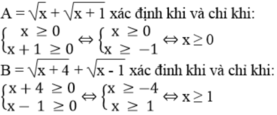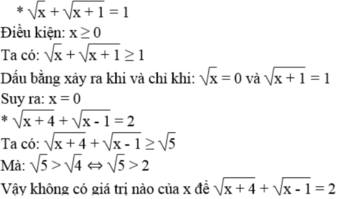Tìm x biết (x+1)2 =(x+1)4
Hãy nhập câu hỏi của bạn vào đây, nếu là tài khoản VIP, bạn sẽ được ưu tiên trả lời.


bài 1 : a,ta có 3/x-1 =4/y-2=5/z-3 => x-1/3=y-2/4=z-3/5
áp dụng .... => x-1+y-2+z-3 / 3+4+5 = x+y+z-1-2-3/3+4+5 = 12/12=1
do x-1/3 = 1 => x-1 = 3 => x= 4 ( tìm y,z tương tự
Bài 1:
a) Ta có: 3/x - 1 = 4/y - 2 = 5/z - 3 => x - 1/3 = y - 2/4 = z - 3/5 áp dụng ... =>x - 1 + y - 2 + z - 3/3 + 4 + 5 = x + y + z - 1 - 2 - 3/3 + 4 + 5 = 12/12 = 1 do x - 1/3 = 1 => x - 1 = 3 => x = 4 ( tìm y, z tương tự )

\(3\left(x-2\right)+4\left(x-1\right)=25\)
\(\Leftrightarrow3x-6+4x-4=25\)
\(\Leftrightarrow7x=35\)
\(\Leftrightarrow x=5\)
\(\left(5x-3\right)\left(x-2\right)=\left(x-1\right)\left(x-2\right)\)
\(\Leftrightarrow\left(5x-3\right)\left(x-2\right)-\left(x-1\right)\left(x-2\right)=0\)
\(\Leftrightarrow\left(x-2\right)\left(5x-3-x+1\right)=0\)
\(\Leftrightarrow\left(x-2\right)\left(4x+2\right)=0\)
\(\Leftrightarrow\left[{}\begin{matrix}x-2=0\\4x+2=0\end{matrix}\right.\)
\(\Leftrightarrow\left[{}\begin{matrix}x=2\\x=\dfrac{-1}{2}\end{matrix}\right.\)

$(x^2-2)^2+4(x-1)^2-4(x^2-2)(x-1)=0$
$\Leftrightarrow(x^2-2)^2-4(x^2-2)(x-1)+4(x-1)^2=0$
$\Leftrightarrow(x^2-2)^2-2\cdot(x^2-2)\cdot2(x-1)+[2(x-1)]^2=0$
$\Leftrightarrow[(x^2-2)-2(x-1)]^2=0$
$\Leftrightarrow(x^2-2-2x+2)^2=0$
$\Leftrightarrow(x^2-2x)^2=0$
$\Leftrightarrow x^2-2x=0$
$\Leftrightarrow x(x-2)=0$
\(\Leftrightarrow\left[{}\begin{matrix}x=0\\x-2=0\end{matrix}\right.\Leftrightarrow\left[{}\begin{matrix}x=0\\x=2\end{matrix}\right.\)
Vậy: $x\in\{0;2\}$.

\(\frac{1-x}{x^2+x+1}-\frac{x-1}{x^2-x+1}=\frac{3}{\left[x\left(x^4+x^2+1\right)\right]}\)
\(\Leftrightarrow\frac{\left(1-x\right)x\left(x^2-x+1\right)\left(x^4+x^2+1\right)}{x\left(x^2+x+1\right)\left(x^2-x+1\right)\left(x^4+x^2+1\right)}\)\(-\)\(\frac{x\left(x-1\right)\left(x^2+x+1\right)\left(x^4+x^2+1\right)}{x\left(x^2+x+1\right)\left(x^2-x+1\right)\left(x^4+x^2+1\right)}\)\(=\)\(\frac{3\left(x^2-x+1\right)\left(x^2+x+1\right)}{x\left(x^2+x+1\right)\left(x^2-x+1\right)\left(x^4+x^2+1\right)}\)
\(\Rightarrow\left(1-x\right)x\left(x^2-x+1\right)\left(x^4+x^2+1\right)-x\left(x-1\right)\left(x^2+x+1\right)\left(x^4+x^2+1\right)=\)\(3\left(x^2-x+1\right)\left(x^2+x+1\right)\)
\(\Leftrightarrow\left(x-x^2\right)\left(x^2-x+1\right)\left(x^4+x^2+1\right)-\left(x^2-x\right)\left(x^2+x+1\right)\left(x^4+x^2+1\right)=\)\(\left(3x^2-3x+3\right)\left(x^2+x+1\right)\)
\(\Leftrightarrow\left(x^3-x^2+x-x^4+x^3-x^2\right)\left(x^4+x^2+1\right)-\left(x^4+x^3+x^2-x^3-x^2-x\right)\left(x^4+x^2+1\right)=\) \(3x^4+3x^3+3x^2-3x^3-3x^2-3x+3x^2+3x+3\)
\(\Leftrightarrow\left(2x^3-2x^2+x-x^4\right)\left(x^4+x^2+1\right)-\left(x^4-x\right)\left(x^4+x+1\right)=3x^4+3x^2+3\)
\(\Leftrightarrow\left(x^4+x^2+1\right)\left(2x^3-2x^2+x-x^4-x^4+x\right)=3x^4+3x^2+3\)
\(\Leftrightarrow\left(x^4+x^2+1\right)\left(2x^3-2x^2+2x-2x^4\right)=3x^4+3x^2+3\)
\(\Leftrightarrow2x^7-2x^6+2x^5-2x^8+2x^5-2x^4+2x^3-2x+2x^3-2x^2+2x-2x^4-3x^4-3x^2-3=0\)
\(\Leftrightarrow2x^7-2x^6+4x^5-2x^8-7x^4+x^2-3=0\)
Đến đây thì chịu òi :^ Sr nha
\(\frac{1-x}{x^2+x+1}-\frac{x-1}{x^2-x+1}=\frac{3}{x\left(x^4+x^2+1\right)}\)
Ta có \(x^4+x^2+1=\left(x^2+1\right)^2-x^2=\left(x^2-x+1\right)\left(x^2+x+1\right)\)
=> \(\left(1-x\right)\left(\frac{1}{x^2+x+1}+\frac{1}{x^2-x+1}\right)=\frac{3}{x\left(x^4+x^2+1\right)}\)
<=>\(\left(1-x\right)\left(2x^2+2\right).x=3\)
Do \(2x^2+2>0\)
=> \(\left(1-x\right).x>0\)
=> \(0< x< 1\)=> \(2x^2+2< 4\)
Pt<=> \(\left(x-x^2\right)\left(2x^2+2\right)=3\)
Mà \(x-x^2\le\frac{1}{4};2x^2+2< 4\)
=> \(VT< 1\)
=> PT vô nghiệm


1) \(\frac{x+4}{2005}\)\(+\)\(\frac{x+3}{2006}\)= \(\frac{x+2}{2007}\)\(+\)\(\frac{x+1}{2008}\)
\(\Leftrightarrow\) \(\frac{x+4}{2005}\)\(+\)1 \(+\)\(\frac{x+3}{2006}\)\(+\)1 = \(\frac{x+2}{2007}\)\(+\)1 \(+\)\(\frac{x+1}{2008}\)\(+\)1
\(\Leftrightarrow\)\(\frac{x+2009}{2005}\)+ \(\frac{x +2009}{2006}\)= \(\frac{x+2009}{2007}\)+\(\frac{x+2009}{2008}\)
\(\Leftrightarrow\)(x + 2009)(1/2005 + 1/2006) = (x + 2009)(1/2007 + 1/2008)
\(\Leftrightarrow\)(x + 2009)(1/2005 + 1/2006 - 1/2007 - 1/2008) = 0
Ta thấy: 1/2005 + 1/2006 - 1/2007 - 1/2008 \(\ne\)0
\(\Leftrightarrow\)x + 2009 = 0
\(\Leftrightarrow\)x = -2009

3) \(x\left(x-4\right)+\left(x-4\right)^2=0\Leftrightarrow\left(x-4\right)\left(x+x-4\right)=0\Leftrightarrow2\left(x-4\right)\left(x-2\right)=0\)
\(\Leftrightarrow\left[{}\begin{matrix}x-4=0\\x-2=0\end{matrix}\right.\Leftrightarrow\left[{}\begin{matrix}x=4\\x=2\end{matrix}\right.\)

x = 1/8 - y/4 = (1-2y)/8
<=> x = 5*8/(1-2y) ; thấy 1-2y là số lẻ nên UCLN(8,1-2y) = 1
do đó x/8 = 5/(1-2y) (*)
x, y nguyên khi 1-2y phải là ước của 5
* 1-2y = -1 => y = 1 => x = -40
* 1-2y = 1 => y = 0 => x = 40
* 1-2y = -5 => y = 3 => x = -8
* 1-2y = 5 => y = -2 => x = 8
vậy có 4 cặp (x,y) nguyên (-40,1) ; (40, 0) ; (-8, -5) ; (8, 5) .

